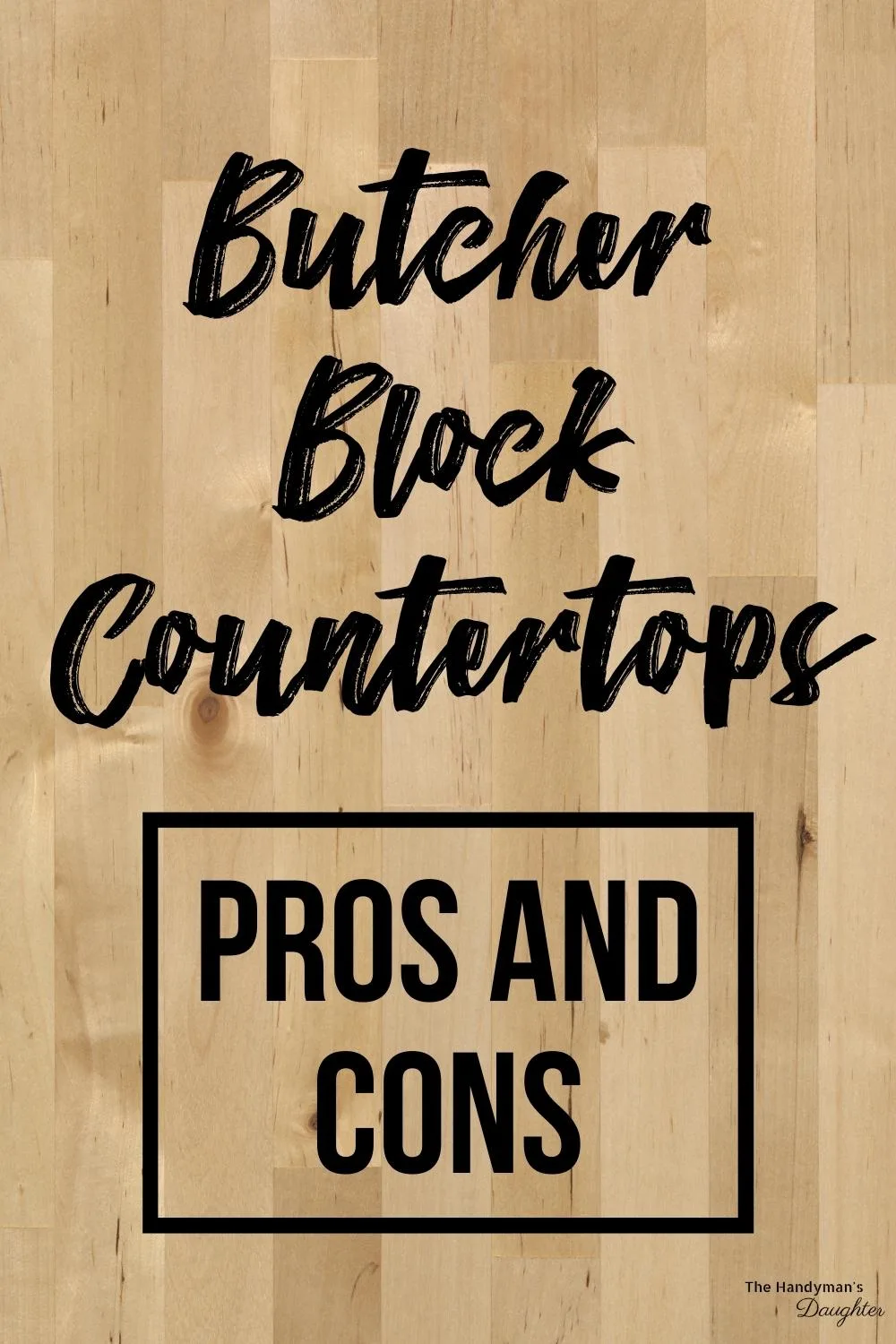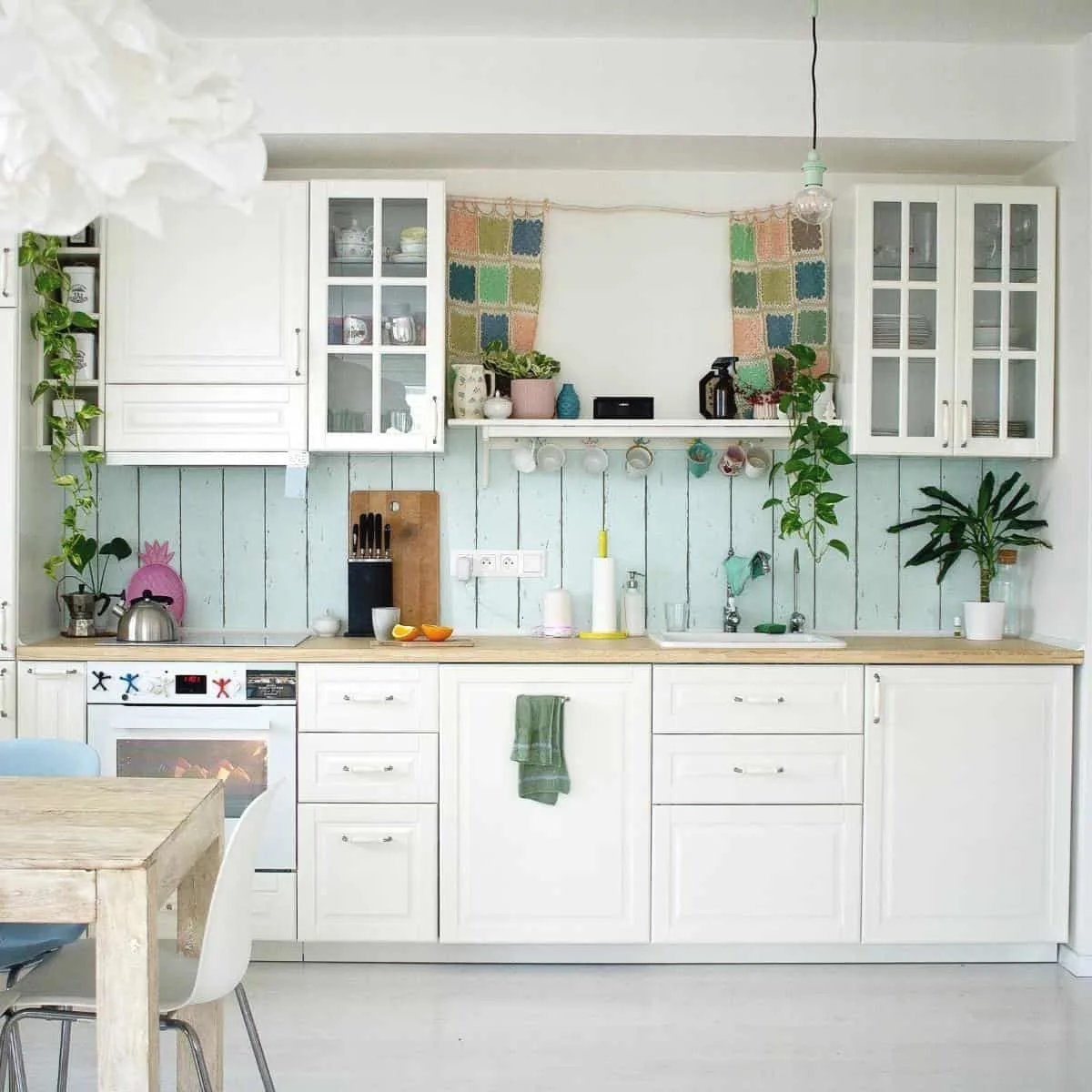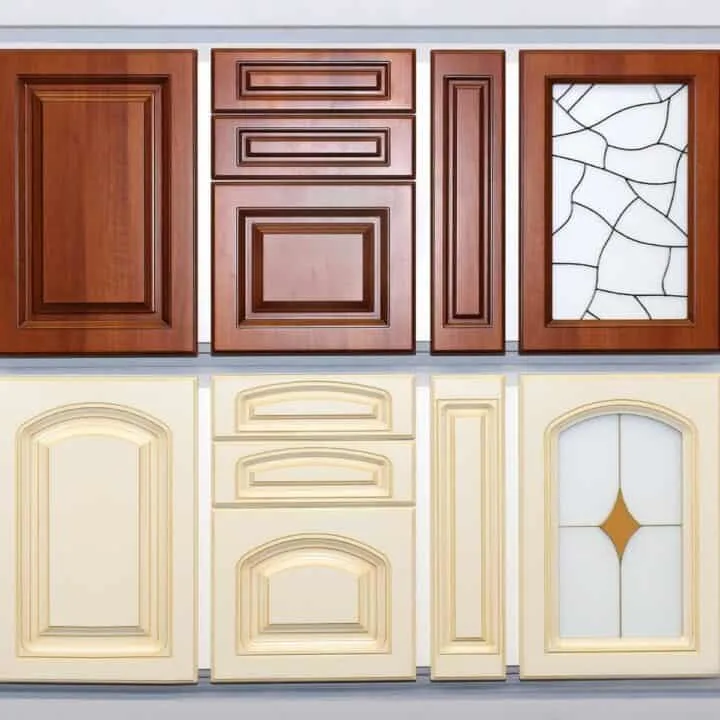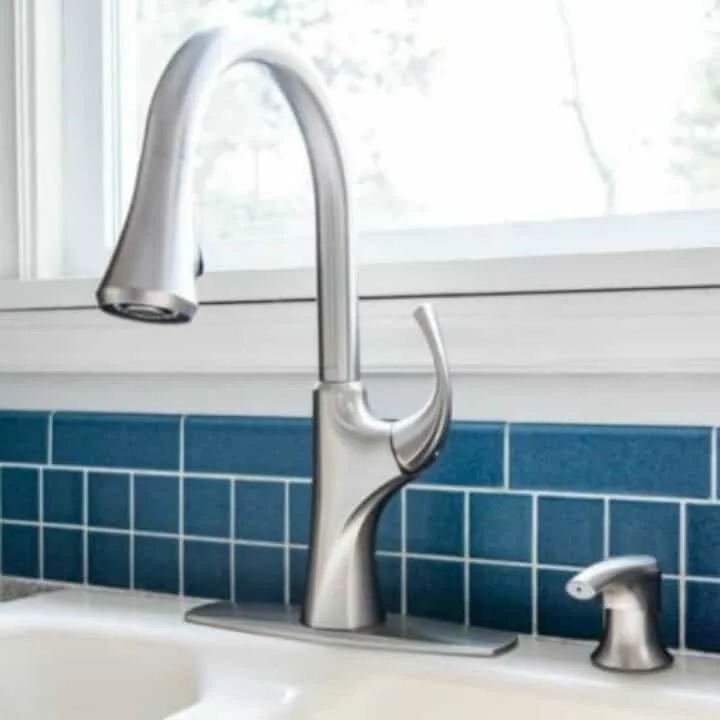How do butcher block countertops compare to stone? I'll share the pros and cons of butcher block countertops so you can decide if they're right for you!

Butcher block countertops are affordable and easy to install yourself. Not only that, but they're warm and welcoming, and add character to an otherwise cold, white kitchen.
However, butcher block countertops also have their share of downsides. If you decide that the cons outweigh the pros, check out my list of 12 different types of countertops to find one that works better for you.
You can learn how to cut, install and seal butcher block countertops in this tutorial! It's easier than you think, and you'll save a ton of money by doing it yourself!

What are the Advantages of Butcher Block Countertops?
Let's start with the positives. As you'll see, many of the pros and cons of these wood countertops will depend on your unique kitchen.
Warm Atmosphere
The butcherblock countertop is just the thing to make your areas welcoming - especially if you have stainless steel appliances and white cabinets! There's something about the natural wood grain that gives your kitchen that cozy farmhouse look.

However, if you're going for a more modern feel, you could stain your countertop a darker shade. Check out my guide to black wood stain colors for some great options. Darker wood colors can look awesome when done right!
Easy to Install
Unlike a stone slab that needs heavy machinery to lift, butcher block can be easily moved around with two people. There's shorter lead times because you can pick it up yourself instead of relying on special trucks and delivery services. Even if you hire someone to install it for you, you'll likely pay less than you would for a stone countertop.
You can also trim it down to size yourself with a circular saw or track saw. Even cutting out sinks and corners is no problem for the average DIY-er.

Relatively Inexpensive
Butcherblock countertops are surprisingly affordable - especially compared to high-end marble or granite! With that said, you can find butcher block countertops in all price ranges.
The least expensive type of butcher block isn't solid wood at all, but more similar to laminate countertops. The manufacturer uses a substrate such as MDF or cheaper wood in the middle, with a nicer veneer on the top, bottom and edges.

One step up in quality and cost is face grain or edge grain butcher block. The longer board sides are glued together to form a large panel. This type is less durable than end grain, but the price per square foot makes it the best bang for your buck.
End grain butcher block is the most expensive, but also the most durable. The end grain of a board can stand up to knife blades and dents, and is basically self-healing. However, the grid of squares isn't to everyone's taste!

Simple to Customize
There are so many options for wood species, oils and stains to customize the look of your wood countertops! The most common types of hardwood for countertops are hard rock maple, white oak, cherry and walnut.
Different finishes will bring out the natural beauty of the wood grain, as well as make it more durable. Mineral oil is the most commonly used oil for surfaces that will be used for food preparation, but it doesn't give much protection.

If you choose to change the color of the wood with stain, you'll also need to apply a protective top coat. This will seal the surface and prevent the stain from leeching through.
Doubles as a Cutting Surface
One of the best reasons to install butcher block countertops in at least one area of your kitchen is that it can double as a cutting surface. If you're always running out of space on your chopping board, imagine how much room you have for food preparation on a huge countertop!

Wood is gentle on knife blades, which makes it ideal for chopping. Make sure you use a food safe oil, and skip the wood stain if you plan to go this route.
When the wood surface gets marked up with lots of cuts and stains, you can sand the surface smooth and re oil the top. You may want to consider adding this chore to your yearly maintenance list, so your wood counters always look like new!
What are the Disadvantages of a Butcher Block Countertop?
No countertop is without its dark side. Even the super expensive ones, like marble, need to be maintained. With that said, there are some common downsides to butcher block countertops.
Knife Marks and Dents
If you chop with sharp knives, you may leave marks on your wooden countertop. Wood is a relatively soft material when compared with stone such as quartz or granite. If you want to avoid chopping marks, you have several options.

First, you can buy a high-end butcher block countertop that is made with end grain. These counters hide and resist scratches well. Second, you could just use a cutting board! Finally, you can always sand the affected area and make it look like new again.
Some people like the knife marks, as it adds to the character of their home. It means your kitchen is well used and well-loved! But if you prefer a smooth, pristine countertop surface, butcher block might not be the right choice for you.
Wood Absorbs Water and Stains
If you don't keep the countertop oiled or sealed, then you could notice swelling or discoloration in different areas of your countertop. This is unlikely if you have an end-grain countertop; however, an edge grain or face grain countertop can absorb water and other liquids.

The most common problem areas are around the sink and prep areas. Clean up water and spills right away to prevent swelling. Also, it's smart to seal your countertops regularly with a waterproof product, or oil that repels water.
If you're careful about moisture, you shouldn't have much to worry about water damage. Just be aware that unchecked water on your butcher block countertop could cause rot and mold, so it's important that you stay on top of your maintenance!
Cracks and Seasonal Changes
Wood moves with the seasons by expanding and contracting as the humidity changes. In fact, if you have a wooden dining table, it will have special table-top fasteners that allow for this seasonal movement.

If you ignore wood movement when installing your countertops, something might split! Either the countertop itself or the base cabinet underneath could crack. To deal with smaller cracks that can appear when the wood is extra dry, be vigilant about applying oil or sealant.
Even though you can't see underneath the countertop, consider sealing both sides to help stabilize the grain. If the countertop does crack, even slightly, water and wood will become trapped in the gap. So, if you notice any cracks, be sure to make fast repairs!
Wood Burns and Stains
This may seem like common sense, but a hot pan can leave burn marks on a butcher block countertop. Also, if red wine spills, you might have a pretty nasty stain! However, if you remember to use hot pads and clean up stains quickly, you shouldn't have major problems.

Key Takeaways on the Pros and Cons of Butcher Block Countertops
Here's the bottom line: butcher block countertops are a great choice for many kitchens. If you're willing to do a little maintenance and take a few precautions, a wooden countertop will serve you and your family for a long time.
They are simple to install, much more affordable than high-end stone options, and they look great! Also - there are tons of possibilities to customize your kitchen!
Keep your countertop well-conditioned and well-sealed to block out moisture. Also, take some time to sand out those cutting marks to keep it looking brand new.
Once you've made your decision, don't forget to check out my guide to cutting, finishing and installing butcher block countertops yourself!







